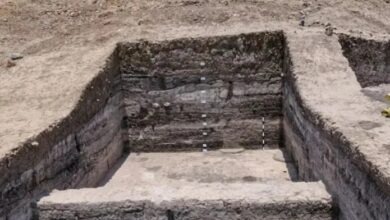5,000-Year-Old Egyptian Artifact Found in Scotland: A Piece of the Great Pyramid’s Mysterious History
News Mania Desk / Piyal Chatterjee / 11th May 2025

An incredible find has occurred at the University of Aberdeen in Scotland, where a 5,000-year-old object from Egypt’s Great Pyramid of Giza was revealed, concealed within an antique cigar box. The fragment, a piece of cedar wood, had been misplaced for decades within the university’s extensive archives. The artifact, one of just three to be removed from within the Queen’s Chamber of the Great Pyramid, is thought to have served as a measuring instrument during the pyramid’s building. The artifact was uncovered during standard archival research, illuminating the historical significance of the Dixon relics and rekindling academic interest in these unique pieces of ancient history.
The piece of cedar wood belonged to the Dixon relics, a small yet historically important collection of artifacts removed from the Great Pyramid in 1872. These artifacts are the sole known items taken from the Queen’s Chamber, making them essential for comprehending the pyramid’s construction and the individuals who created it. Abeer Eladany, an archaeologist seasoned in Egyptian excavations, was the person to discover the concealed artifact in the university’s archives. Upon cross-checking the artifact against the museum’s documentation, she swiftly understood the item’s actual importance.
“Once I looked into the numbers in our Egypt records, I instantly knew what it was, and that it had effectively been hidden in plain sight in the wrong collection,” said Eladany. “I’m an archaeologist and have worked on digs in Egypt but I never imagined it would be here in north-east Scotland that I’d find something so important to the heritage of my own country.”
The discovery came after Eladany was going through the university’s extensive archives. Among thousands of items, the cedar fragment had been misfiled and forgotten. “The University’s collections are vast – running to hundreds of thousands of items – so looking for it has been like finding a needle in a haystack,” said Neil Curtis, Head of Museums and Special Collections at the University of Aberdeen. “I couldn’t believe it when I realized what was inside this innocuous-looking cigar tin.”
While the cedar wood piece was initially hard to recognize, it has now been verified as a remarkably rare artifact, providing fresh perspectives on the ancient world. Radiocarbon dating of the timber indicated that it originates from between 3341 and 3094 B.C., a time that is about 500 years before the Great Pyramid was built. This finding prompts significant inquiries regarding the source and intent of the wood. Researchers think that the wood could have served as a measuring instrument or a type of survey marker while the pyramid was being built, although more investigation is necessary.
The journey of the relics through time also reflects a more somber aspect of archaeology’s history. The artifacts were initially collected by Waynman Dixon and James Grant during an excavation permitted by the Egyptian Antiquities Service in the 19th century. Although these excavations were prevalent, they also exhibited an extractive perspective on archaeology, as artifacts were taken from their cultural settings and stored in the collections of European museums or private ownership. In this instance, Dixon and Grant held onto the items, with Dixon taking the hook and ball and Grant keeping the cedar piece.
Following Grant’s passing in 1895, his assortment of artifacts was donated to the University of Aberdeen. Nonetheless, the cedar piece was inadequately documented and went missing in the archives for many years. This event demonstrates how the trade in antiquities during the colonial period led to numerous artifacts being dispersed globally, frequently without consideration for their original cultural importance.






